|
Back in Hobart Karen and I decided upon a short walk south of Sandy Bay to an historic site known as the Shot Tower. The tall, brick structure resembled a huge chimney from the outside, but the inside revealed a staircase spiralling upwards around a central cavity to a platform at the top. In days of yore, molten lead would be hauled up to this platform and poured into a variety of sieves, with droplets of the hot metal cooling into perfect spheres as they fell. These received a final quenching in a water reservoir at the base of the tower. This "shot" was used for a variety of purposes, mostly for military weapons.
Having just discovered that we were not fond of adverse conditions on high mountains, Karen and I soon found out that our map reading skills needed a lot of work as well. Our walk down to the Shot Tower had appeared a mere doddle on the tourist brochure, but it soon developed into an epic two hour trip as we realised we had mis-read the scale of the map. We made our return journey to the caravan park by bus. With the two experiences of Mount Anne and the Shot Tower fresh in our minds, Karen and I made the perverse decision to attempt one of the most difficult short wilderness walks in Tasmania - the ascent of the mountain known as Frenchman's Cap. It had been disappointing not to bag Mount Anne. That disappointment could only be compensated by claiming an even greater prize.
Situated in the Franklin-Lower Gordon Wild Rivers National Park and rising to a height of fourteen hundred and forty three metres, eighteen metres higher than Mount Anne, Frenchman's Cap is named after the piece of head wear it is said to resemble. Karen and I are not too familiar with European millinery and have never seen the similarity, preferring to describe the mountain like an old fashioned fireman's helmet, the front vertical above the rim before sloping down gradually at the back.
"There is also the real risk of bad weather and snow, making this a walk for the experienced walker only. Warm and waterproof clothing to cope with blizzard conditions is essential at any time of the year." So says Tyrone Thomas. With my only pair of hiking pants having fallen apart during the Mount Anne walk, I bought a pair of brown slacks from the St. Vincent de Paul Society shop for two dollars. Such was the quality of my hiking apparel.
The walk starts from a bus stop about thirty kilometres west of Derwent Bridge in central Tasmania. It is over twenty kilometres from the highway to the summit over the worst track we have ever had the misfortune to tread. Because of the remoteness of the walk, the height of the mountain, the mud-puddle pretending to be a track and the notorious weather we were likely to encounter, Karen and I decided to attempt the walk only after discovering that two huts were positioned along the track to the mountain. We were confident of our navigational abilities, fitness and endurance, but Tasmanian weather can be a real killer. Huts are like oases in the desert or islands in the ocean - safe havens when conditions become too much.

Karen crossing the Franklin
We bussed out to the start of the walk and made sure the driver knew we would need to be picked up three days later. The track descended to the Franklin River where a new bridge made crossing easier than the flying fox which had been used in the past. We followed a good track through forest and up to a high point where we gained our first view of our objective, the quartzite rock of Frenchman's Cap making it appear snow covered.

Our first view of Frenchman's Cap
Six kilometres into the walk we came to the Loddon River and the start of the infamous "Sodden Loddon" plains. We crossed a small suspension bridge, made our way along a reasonable track through melaleuca swamps, then topped a rise and descended into hell.
The track led down to a large, black bog. Impossibly thick stands of ti-tree lined both sides of the route, making avoidance of the obstruction impossible. Ten metres away, directly across the bog from where we stood, the track rose out of the mire and carried on. We had no other option than to cross. Even so, we tried to skirt around the outside, trying to find footholds to keep from sinking into the bog, but it was no use. We emerged from the other side only slightly dirty, but worse bogs lay ahead.
With the benefit of hindsight, Karen and I would have been much better off to have simply jumped into the first bog to get it all over and done with. Then, once we were well and truly filthy, we would not have attempted the time consuming and ultimately futile task of trying to stay clean. Sections of solid, wide track across the plains were interspersed with unavoidable mud pits. We squelched through sections fifty metres long, often plunging in to mid thigh. Having boots or shoes sucked off by the clinging ooze was a constant concern, with every step a danger.
On the Overland Track we had encountered some muddy sections and skirted around them, as had hundreds of people before us, enlarging the boggy areas and causing massive erosion problems along the track. Some bogs had been a hundred metres wide, but still we had gone around. Boardwalks had been built out of necessity. The low-lying Loddon Plain with its impenetrable stands of ti-trees however, allows only one track - all of it bog - and as a result boardwalks are at a much lower priority, even if considered at all.
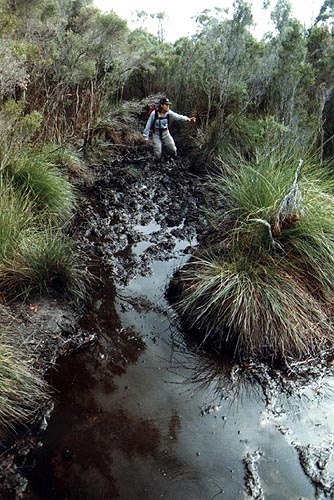
The bogs of the sodden Loddon Plain
After a brutal afternoon of only fourteen kilometres, Karen and I arrived at Lake Vera, and the beautiful sight of Vera Hut. We dumped our packs on the verandah and wandered down to the water, wading in up to our knees in a vain attempt to get the bog out of our trousers and shoes and socks. Back at the hut, we wrung as much water as we could from our clothes then opened the door to find a small assortment of fellow hikers inside. The hut was big, with room for twenty or more people. We claimed a couple of bunks, hung up our clothes to dry, and set about doing all the usual evening activities at the end of a long day's walk - getting mats and sleeping bags ready, preparing and eating dinner, getting stuck into some chocolate, making hot coffee, and talking to all of our new-found sleeping companions.
The following day was overcast, but with only two days to climb the mountain before we had to walk back out, we did not really have the luxury of hoping the next day would be better. Leaving the bulk of our gear at the hut, we headed for Frenchman's Cap, our day-packs loaded with food, water, cameras, wet weather gear and thermals. The track around Lake Vera was wicked - a wet and slippery meander over a maze of tree roots. Then the climbing began. The summit of the mountain is almost a full kilometre higher than the lake.
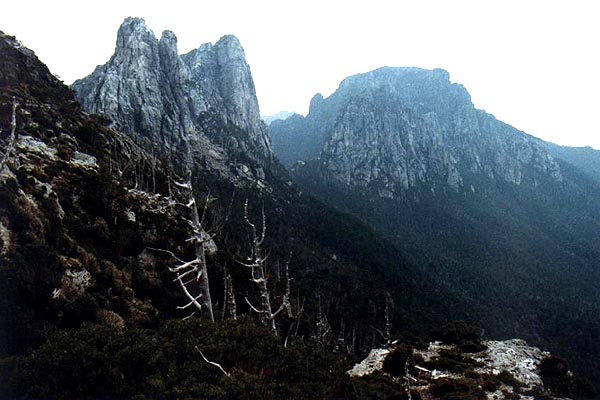
Barron Pass
After an hour of hard work we arrived at Barron Pass, a narrow saddle between Sharland's Peak and White Needle. Karen and I had warmed up nicely on the climb, but a bitterly cold wind which had been unnoticed in the lee of the surrounding mountains made sightseeing from the pass somewhat uncomfortable. Three kilometres away, the vertical eastern face of Frenchman's Cap appeared above an intervening ridge, dropping away to a series of lakes gouged out by ice-age glaciers. Karen and I took a couple of photographs, then hunkered down below the saddle for a quick snack out of the wind.
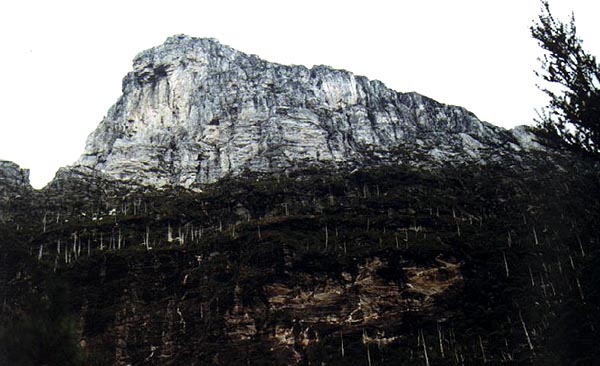
The face of Frenchman's Cap
The next three kilometres to a hut at Lake Tahune, directly below the summit of the mountain, saw no gain in elevation. We traversed across a steep slope below Sharland's Peak before climbing to a rocky outcrop. Below us lay Artichoke Valley, a striking green carpet of alpine bog interspersed with the white skeletons of dead King Billy pines. A small climb out of the valley led to a short, sharp descent to the Lake Tahune Hut. Only one hiker was in residence, his gear spread out from one end of the small hut to the other. We spoke to the guy about the route to the top before setting off again for the final push. In just over one kilometre we would climb almost five hundred metres.

Karen amongst the pines in Artichoke Valley
The climb was not difficult. It was a walk up a mountain rather than a scramble. The final few hundred metres up the curved back of Frenchman's Cap led us over a rubble field of broken quartzite dotted here and there with tiny alpine flowers, seemingly delicate but obviously stronger than they looked to survive such a hostile environment. We passed the large, tetrahedral trig and descended slightly to arrive at the vertical face. The view, indeed the whole experience, was awesome.
Karen describes getting to the top of Frenchman's Cap as her "Everest." The summit of the mountain is significantly higher than any of the surrounding peaks, making them shrink almost to insignificance and giving the impression that we were standing on top of the world. Adding to this feeling was a thin cloud layer a few hundred metres below our feet, partially obscuring the glacial lakes in the valley beyond. On the horizon to the east the silhouettes of Cradle Mountain and Barn Bluff loomed above cloud-filled valleys and misty ridges.
The guy from the hut soon joined us. Although he had climbed the mountain the day before, he had been so impressed with the whole experience that a second arduous climb was more appealing than spending a few more hours in the security of the hut. A photo he took of Karen and myself leaning against the trig shows a mass of cloud boiling up behind us. Shortly after the picture was taken, the cloud enveloped us, pushed upwards by the cold, ever-present wind.
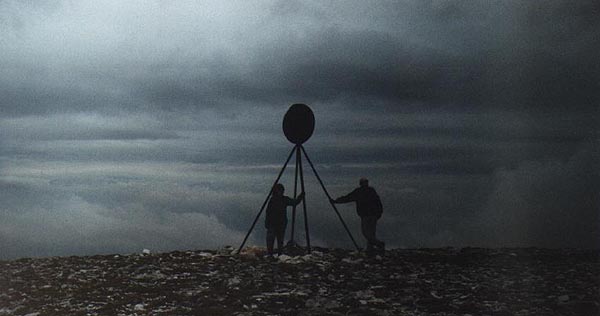
Karen, me and the Frenchman's Cap trig
Some thoughtful souls had built a small, stone walled bunker near the top of the vertical drop off, and the three of us sheltered within it as we all shared our lunch. We all returned to the hut shortly afterwards, driven down by the cold and the lack of views.
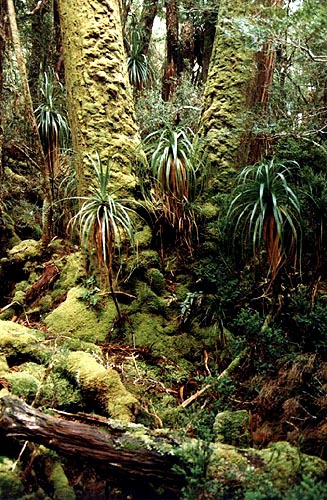
Myrtle rainforest on the way to Frenchman's Cap
Karen and I retraced our steps of the morning back to Lake Vera. A party of two teachers and a dozen teenage boys from a private school shared the hut with us that night, a situation which would have been untenable for us had it not been for the humour, intelligence and respect of the kids. While they went out to do battle with the mountain the next day, Karen and I spent a rest day at the hut. We had given ourselves the extra day in case of bad weather, not wanting to be disappointed as we had been on Mount Anne.
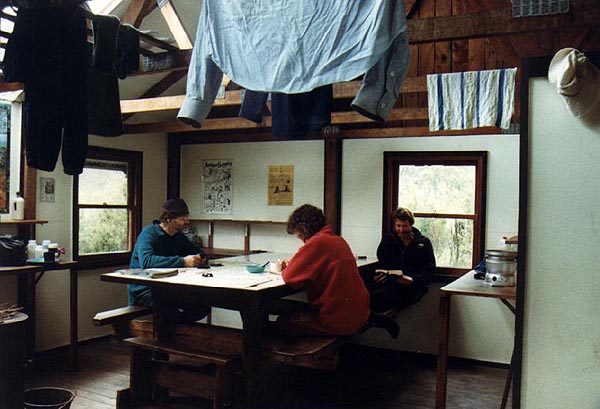
A quiet day in Lake Vera Hut
The walk out through the bogs of the Loddon the following day was much quicker than the walk in. We knew what to expect, knew that there was no way around, and knew that the bus would not wait for us if we arrived late. After crossing the bridge over the Franklin Karen and I walked down to the edge of the river and again attempted to remove as much mud as possible from our pants. We turned the pristine waters into a brown, cloudy soup, but the rinsing was only partially effective. I still have Loddon bog in those pants today.
Karen and I climbed up from the Franklin to the road and settled down in the sun to dry and to have a lunch of the last of our food while waiting for the arrival of the bus. When it finally appeared, we picked up our packs and stood up. The bus kept coming. When it was about fifty metres away we realised that the driver had no intention of stopping. Karen and I quickly started waving our arms in a desperate attempt to attract the driver's atention. We saw the surprised look on his face as he went past. Visions of being stuck in the wilds of Tasmania flashed into our minds. No food, no transport, not much fun. To our great relief, the bus stopped just up the road. We wasted no time in boarding. The driver checked his manifest and showed us that no passengers had been due for pickup from the bus stop.
It was a memorable finish to a memorable walk.
|








